It’s like Duolingo, but designed for Model UN parents like you!
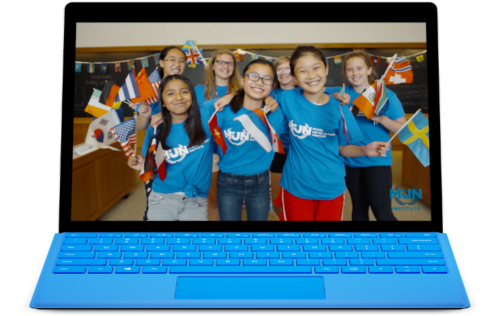
Does it sometimes sound to you like your kid is speaking another language when they’re talking about Model UN? Do you find yourself confused about what exactly your child is doing when they participate in MUN in the first place? Have no fear – with these 26 key terms, you’ll have a handy translation guide for the next time your kid brings up all things MUN & FUN!
This handy MUN translation article is written in 6 sections to help guide you through each aspect of your child’s MUN experience, beginning with general terms & concepts and taking you through conference & committee specific lingo. You’ll also find top parent tips on how and when to use these terms & ideas to best engage with your child’s MUN preparation process & journey! Sections include: 1) MUN defined & explained, 2) research stage terminology, 3) starting committee terminology, 4) debate stage terminology, 5) negotiation stage terminology, & 6) resolution stage terminology.
Are you ready to become an expert MUN parent?
(If your child has just started their MUN journey and doesn’t know some of these terms yet, that’s okay! It’s all part of the MUN experience!)

Model UN Defined & Explained
At some point, you’ve probably found yourself wondering “what is Model UN and how exactly does it help to prepare my child to succeed & engage with the world?” Model UN is an incredible opportunity that allows your child to step into the shoes of global leaders and work alongside like-minded peers to create positive & sustainable solutions to today’s most pressing global challenges. Through participating in MUN, students learn public speaking, negotiation, writing, and critical thinking skills as they grow in confidence and gain leadership experience! If your next question is, “well how on earth is my child going to be able to do any of that?” you’re not alone and this section will help you understand how exactly MUN will turn your child into a youth diplomat, advocate, & leader!
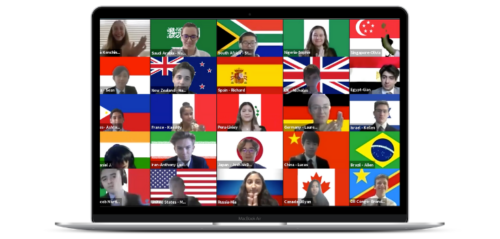
1. Model UN Conference: Model UN Conferences are hosted by organizations, universities, or even local high & middle schools with Model UN programs! Model UN conferences typically bring together students from multiple schools & Model UN teams to compete in a number of different committees, each focusing on a different topic of interest (to be explained below). Conferences can be in-person or virtual, are typically 1 – 4 days in length, and may include additional programming for students including engaging speakers, panels, & events.
2. Model UN Committee: Model UN committees are the specific forum in which your child will step into the shoes of a global leader to debate one of today’s most pressing challenges! Committees are drawn from the structure of the United Nations itself, and include, for example, General Assembly committees, with each student assigned to represent a specific UN Member State on an assigned topic. Committees will typically have anywhere from 15 – 193 countries represented. Example common topics include a Disarmament and International Security (DISEC) committee focused on Nuclear Disarmament, or a United Nations Children’s Fund (UNICEF) committee focused on Universal Access to Quality Education. If ever you hear your child throw out an acronym with “UN” somewhere in it in reference to an upcoming conference, they’re probably referring to the committee they’ll be participating in! Note: in Model UN, there are also crisis-style committees that may feature historical, contemporary, or even fiction/fantasy topics.
3. Stages of a Model UN Committee: To break MUN committees down for you a little further, you can think about the MUN process as having 5 stages: 1) research, 2) debate, 3) negotiate, 4) resolution, & 5) action. Each MUN committee your child participates in will take them through & follow these five stages, allowing them to come to a consensus with their peers on solutions to the topic at hand! The rest of this article is constructed to help you put your child’s experience into the context of each of these stages, and to allow you to engage with their MUN preparation journey.

4. Rules of Procedure/Parliamentary Procedure: Model UN committees are directed and guided by what are known as “rules of procedure” or “parliamentary procedure.” Have you ever wondered how exactly your child manages to represent a particular country and step into the role of a diplomat for a day? Rules of procedure are the “how;” they take the processes used by countries & leaders within the UN to manage & run each session and translate them to the student Model UN context! When your child walks away from a conference and committee, they can truly say they’ve spent the day or weekend embodying UN principles & practices! Many of the terms that follow in this article are drawn from parliamentary procedure.
5. Western Business Attire: A major part of Model UN is being able to fully represent an assigned country and step into the shoes of international diplomats, which includes dressing like a professional! If you’ve ever heard your child mention “Western Business Attire” or “WBA,” they’re referring to the conference’s dress code.

Research Stage Terminology
MUN Parent Cheat Sheet: these terms will help you engage with your child’s preparation process!
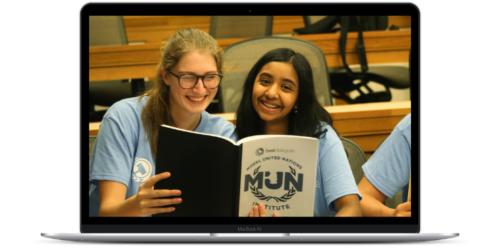
6. Background Guide: Your child will be provided with a background guide in the weeks leading up to a MUN conference. Each background guide is specific to the committee & topic your child has been assigned to represent & debate, and they’re provided as a helpful resource to frame your child’s understanding of the topic and to help them begin their research process. Background guides typically include an introduction & history of the topic at hand, past international actions undertaken by the UN & the international community to solve the topic, the contemporary situation, sub-topics to consider, possible solutions, and further ideas for jumpstarting the research process. Once your child has their background guide, you can go through it with them to help them engage with and understand their upcoming committee topic! Pro tip: if you want to help your child deep-dive on their research process, definitely look to the research sources & questions included in the background guide as a starting point!
7. Country Policy: As your child researches for their upcoming Model UN committee, a key element of this process is understanding their country policy, or what their country believes the UN should do in order to solve the particular global issue they’ve been assigned. Model UN is a unique form of debate in that it allows your child to step into & understand a new perspective, which they do by learning as much as possible about the viewpoints, interests, & goals of their country (and the countries other students have been assigned to represent throughout the committee!).
8. Position Paper: Many Model UN conferences will require your child to submit a position paper prior to the start of the conference. A position paper is typically a 1-2 page paper in which your child will explain their country’s stance & policy related to the topic at hand. The best position papers should strive to go beyond what’s already happened and what your child has found in their research, and also propose possible solutions that your child plans on advocating for throughout the conference. Pro tip: your child can and should also use what they write in their position paper to help form their speech & resolution ideas moving forward – position papers are a great research resource to continuously refer back to!

Starting Committee Terminology
MUN Parent Cheat Sheet: these terms will help you familiarize yourself with your child’s world of diplomacy and their experience participating in the MUN process!
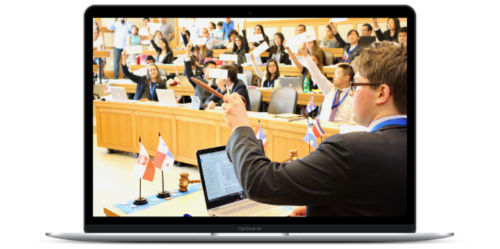
9. Chair: The Chair or Chairs are the ones who will be facilitating the flow of your child’s MUN committee, and are typically expert university or high school MUN students depending on the conference. At in-person conferences, the chairs will be seated at the front of the room with a gavel and typically a projected screen that helps students to follow-along with what’s happening. Chairs call on speakers, time speeches, and maintain the rules of procedure for the committee while also evaluating your child’s performance in the case the conference gives awards. If your child would like feedback on their performance at the end of a given committee, they should definitely ask their Chair!
10. Delegate: A delegate refers to a person sent to a conference to represent a group or a country. In a Model UN committee, your child becomes a delegate, specifically the delegate of the country or government they’ve been assigned to represent! This is an important part of how MUN creates the environment for your child to step into the shoes of a world leader!
11. Placard: At in-person conferences, your child will be given a large name card that will typically have the name of their country and/or position written on it. The purpose of placards is for the Chair to be easily able to call on and recognize delegates as their countries, and for your child to easily be able to participate throughout the committee! Sometimes, at the end of conferences, students will sign each others’ placards as they create new memories & make new friends from the experience!
12. Decorum: Decorum refers to order within the committee. The Chair of the committee may call for decorum if delegates are loud, disrespectful, or to ask for the attention of all of the delegates present. Essentially, it’s a mechanism for the Chair to ensure everyone continues to emulate the values of diplomacy throughout the committee.
13. Points: Over the course of your child’s committee, the Chair will consistently ask if there are any points on the floor. Points serve the purpose of improving the delegate experience, and your child is able to raise three types of points: 1) point of inquiry, 2) point of order/parliamentary procedure, and 3) point of personal privilege. A point of inquiry is simply a question about what’s going on or about the committee topic. A point of order/parliamentary procedure is used in the case delegates would like to correct a mistake in procedure made by the Chair, for example if the Chair sets the timer to an incorrect speaking time. A point of personal privilege is to improve your child’s experience, and can be brought up if, for example, they can’t hear a speaker or the room is too hot or too cold.
14. Motions: Along with points, the Chair of the committee will also continuously ask for motions. Motions are how your child and their peers/fellow delegates determine how committee proceeds or moves forward (think motion = movement!), and each motion is a specific action made by a delegate to direct debate in a certain direction. One of the coolest parts about Model UN is that it’s the delegates who determine which sub-issues they debate, and when certain actions take place, which is achieved through proposing motions. Continue reading to learn what exactly these motions might look like!

Debate Stage Terminology
MUN Parent Cheat Sheet: your child will use these terms when describing the speeches they prepare for & deliver throughout committee – use these terms to help them practice & feel confident about their speeches!

15. Speakers’ List: The Speakers’ List is where your child will get to deliver their first speech of the committee, known as their Opening Speech! Once the committee starts, a delegate will make a motion to open the Speakers’ List, and the Speakers’ List will contain the order in which delegates will deliver their opening speeches, which are typically around 1-minute long. This is the default format of debate, and committee will proceed with the Speakers’ List until a motion is made to change the format of debate. In order to be added to the Speakers’ List and deliver their opening speech, your child simply has to raise their placard, or in the case of zoom, a virtual hand!
16. Yield: At the end of an opening speech during the Speakers’ List every delegate has to yield, or give up, their remaining time. Once your child says “thank you,” they have 3 options in terms of yielding: 1) back to the chair (the time simply elapses), 2) to another delegate (that student gets to speak for the remaining time), or 3) to questions (other delegates will ask your child questions about their speech, which they can answer during the remaining time).
17. Moderated Caucus: Moderated Caucuses are a form of debate that allows your child and their fellow delegates to comment on specific sub-issues related to the topic (hint: ideas for these can be found in the background guide!). Unlike the Speakers’ List, where every delegate can broadly discuss their country’s policy, during Moderated Caucuses, students will all focus on different specific elements of the topic to come up with concrete solutions. Delegates should raise their placard to be recognized, and speakers are called on one at a time to allow debate to be responsive & conversational. Motions must include a total time, speaking time, and topic. An example of a motion your child could make in a committee focused on Universal Access to Quality Education: motion for a 10-minute moderated caucus with a 30-second speaking time to discuss education in conflict settings (this specific motion would allow a total of 20 students to each give a 30 second speech regarding their country’s thoughts & solutions for education in conflict settings).

Negotiate Stage Terminology
MUN Parent Cheat Sheet: these terms describe the networking & alliance-building process of MUN, which heavily relies on teamwork & making new friends!
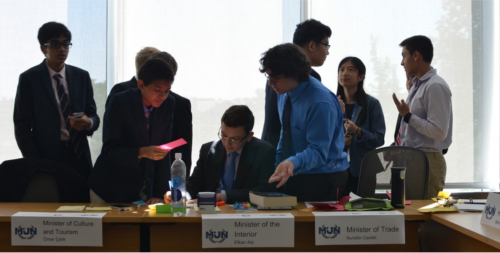
18. Unmoderated Caucus: Unmoderated Caucuses are a debate format in which your child will be able to move around the room, or in the case of virtual MUN join a breakout room, and talk freely and informally with their fellow delegates about the topic and their possible solutions. During unmoderated caucuses, your child will find allies, form a bloc, and work on their draft resolution alongside their peers. A motion for an unmoderated caucus only requires a total time, so an example motion would look like this: motion for a 10-minute unmoderated caucus.
19. Blocs: In Model UN, a bloc refers to a group of different countries who have similar ideas & opinions on the topic at hand. Delegates will write their draft resolutions within these blocs. In the United Nations itself, there are regional blocs, but MUN delegates can choose to build their own blocs based on similar country policies, which they find by listening to other students’ speeches!

Resolution Stage Terminology
MUN Parent Cheat Sheet: the goal of any MUN committee is to solve the global issue being discussed, which happens through writing & passing resolutions, just like in the real UN! In order to help your child prepare for resolution writing, you can help them to brainstorm ideas for possible solutions & review some of these key terms!
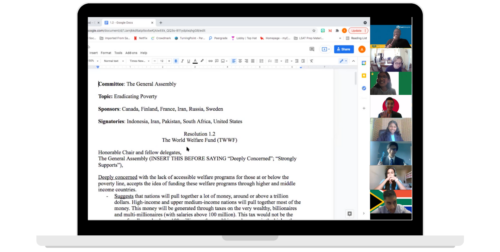
20. Resolution: A resolution is a written document that outlines problems & past international actions associated with the topic, and most importantly includes solutions to the issue that your child develops collaboratively alongside their fellow delegates (bloc members) during unmoderated caucuses. Your child’s main goal in any MUN committee is to pass a resolution.
21. Working Paper: A working paper refers to the list of ideas formed by a bloc that may or may not be written in resolution format. Working papers must be approved by the Chairs in order to be transitioned into draft resolutions.
22. Draft Resolution: A draft resolution is a document written in resolution format that’s been approved by the Chairs and introduced to the committee BUT not yet voted on. Delegates spend most of their time during committee writing and amending draft resolutions, specifically during unmoderated caucuses. They become resolutions once they are passed by the committee during voting.
23. Sponsors: Sponsors are the delegates who author or actively contribute ideas to a given draft resolution. Sponsors typically support the draft resolution and want to see it pass, meaning they should vote in favor of it at the end of committee! The concept is similar to your child putting their name at the top of a homework assignment, making it clear that the work belongs to them. Hint: you should always encourage your child to be a sponsor on a draft resolution!
24. Signatories: Signatories are delegates who wish to see a resolution debated but may or may not agree with all of the ideas and solutions presented. They see merit in the draft resolution, and as such want to see it presented to the committee. Pro-tip: your child can be a signatory on multiple draft resolutions, and it shows support for their peers’ ideas!
25. Pre-ambulatory Clauses: Pre-ambulatory clauses are the first section of a formatted draft resolution, and can be thought about like the introduction to a paper. They describe the problems/issues being addressed and previous measures that have been taken to combat the global challenge. The first word of a pre-ambulatory clause is typically italicized or underlined and they end with a comma. Example pre-ambulatory clause for Universal Access to Quality Education: Noting that SDG 4, Quality Education, calls for the international community to unite in in the creation of opportunities for education for all.
26. Operative Clauses: Operative clauses are the second section of a formatted draft resolution, and can be thought about like the main argument being made in a paper. They outline the solutions that your child and their fellow bloc members would like to implement, and typically, a great draft resolution should have more operative clauses than pre-ambulatory clauses (think more solutions than issues!). These are typically numbered, the first word/operative statement is underlined, and they each end with a semicolon (the last one will end with a period). Example operative clause for Universal Access to Quality Education: Recommends that all UN Member States implement universal free pre-primary and primary education.

MUN Parent Action Stage
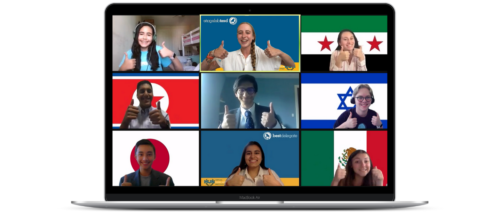
Congratulations! You’ve learned 26 key Model UN terms & familiarized yourself with your child’s new world of diplomacy! While your child’s task during the action phase of MUN is to vote on & get their resolution passed, for the purpose of this article, your task is to get involved with your child’s MUN journey and help them get excited for their next committee!


